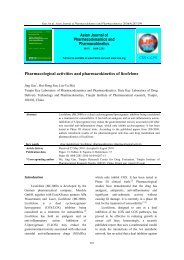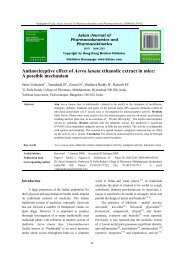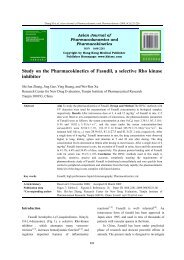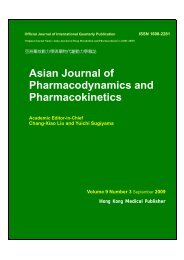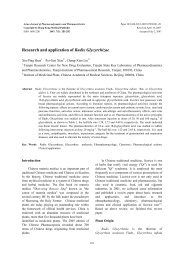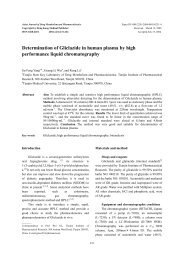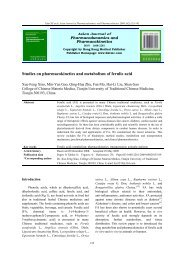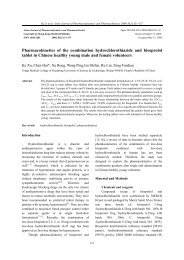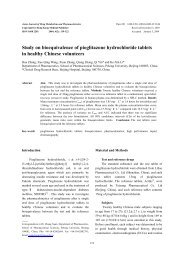Asian Journal of Pharmacodynamics and Pharmacokinetics
Asian Journal of Pharmacodynamics and Pharmacokinetics
Asian Journal of Pharmacodynamics and Pharmacokinetics
Create successful ePaper yourself
Turn your PDF publications into a flip-book with our unique Google optimized e-Paper software.
Cheng TF et al. <strong>Asian</strong> <strong>Journal</strong> <strong>of</strong> <strong>Pharmacodynamics</strong> <strong>and</strong> <strong>Pharmacokinetics</strong> 2009; 9(1):27-49<br />
the most attractive areas <strong>of</strong> research in drug delivery<br />
is the design <strong>of</strong> nanomedicines consisting <strong>of</strong><br />
nanosystems that are able to deliver drugs to the<br />
right place, at appropriate times. The goal <strong>of</strong> the<br />
present article is to review the advances we have<br />
made in the development <strong>and</strong> characterization <strong>of</strong><br />
nanosystems intended to be used as drug carriers for<br />
mucosal administration. These nanocarriers are able<br />
to protect the associated drug against degradation<br />
<strong>and</strong> facilitate its transport across critical <strong>and</strong><br />
specific barriers. Some are further able to release<br />
the associated drug to the target tissue in a<br />
controlled manner. These nanocarriers have been<br />
made <strong>of</strong> safe materials, including synthetic<br />
biodegradable polymers, lipids <strong>and</strong> polysaccharides.<br />
The change in the physicochemical <strong>and</strong> structural<br />
properties <strong>of</strong> engineered nanosized materials with a<br />
decrease in size could be responsible for a number<br />
<strong>of</strong> material interactions that could lead to<br />
toxicological effects. At present, scientists must<br />
accept that it is still very early in the toxicological<br />
evaluation for nanomaterials <strong>and</strong> nanomedicines,<br />
<strong>and</strong> few data on the safety <strong>and</strong> toxicity. The safety<br />
evaluation <strong>of</strong> nanomedicines includes workforce<br />
exposure limits in manufacturing process,<br />
environment impact with general impact <strong>and</strong> to<br />
patients after administration <strong>and</strong> safety for human<br />
use, such as depends on route <strong>of</strong> administration,<br />
dose <strong>and</strong> dosing frequency, as well as safety in drug<br />
delivery relates to toxicity <strong>of</strong> drug payload. The<br />
biomedical evaluation <strong>of</strong> nanomedicines includes<br />
biodistribution, metabolic fate, Persistance <strong>of</strong><br />
non-degradable systems, Specific therapeutic issues<br />
<strong>and</strong> immunogenicity. We must pay an attention on<br />
the relative issues <strong>of</strong> nanomedicines with human<br />
health <strong>and</strong> safety <strong>and</strong> toxicity to develop the<br />
evaluation methods <strong>of</strong> nanoproducts <strong>and</strong> make<br />
nanotechnology play a great role in the progress in<br />
nanotechnology <strong>and</strong> medicines <strong>and</strong> medicine<br />
engineering .[5]<br />
Evaluation on safety <strong>and</strong> toxicology <strong>of</strong><br />
nanomedicines<br />
The toxicology <strong>of</strong> nanomedicines used in<br />
device manufacture should be considered during<br />
their entire life cycle at stages <strong>of</strong> manufacture <strong>and</strong><br />
preclinical <strong>and</strong> clinical development, consumer <strong>and</strong><br />
staff safety <strong>and</strong> waste management in environment.<br />
The development <strong>of</strong> in vitro models <strong>of</strong> testicular<br />
toxicity may provide important tools for<br />
investigating specific mechanisms <strong>of</strong> toxicity in the<br />
testis. Although various systems have been reported,<br />
their application in toxicological studies has been<br />
limited by the poor ability to replicate the complex<br />
biochemical, molecular, <strong>and</strong> functional interactions<br />
observed in the testis. In vitro models have been<br />
established, <strong>and</strong> some <strong>of</strong> them have tried to<br />
reproduce the complex interactions that take place<br />
between the different germ cells. These models are<br />
limited by the poor viability <strong>of</strong> freshly isolated germ<br />
cells. So the development <strong>of</strong> a germ-line stem cell is<br />
<strong>of</strong> great interest. After previous studies to develop<br />
an immortalized cell line [6-8] with promising<br />
application in the study <strong>of</strong> testis toxicity. In vivo<br />
system for evaluation on safety <strong>and</strong> toxicology is<br />
very importance. This evidence <strong>of</strong> physiologically<br />
significant histopathological changes clearly<br />
indicates the potential <strong>of</strong> these nanomaterials for<br />
human toxicity at realistic doses.<br />
Nanoscale materials are seeming application in<br />
direct interventions to improve public health both<br />
through therapeutic strategies <strong>and</strong> environmental<br />
remediation. Recent years have seen the emergence<br />
<strong>of</strong> nano-engineered drug delivery strategies.<br />
Approval <strong>of</strong> abraxane, a nano-formulation <strong>of</strong> taxol<br />
for the treatment <strong>of</strong> breast cancer, was received by<br />
Food <strong>and</strong> Drug Administration (FDA), USA. This<br />
protein nano-bead conjugated pharmaceutical has<br />
increased water solubility allowing for elimination<br />
<strong>of</strong> the toxicity associated with the solvent vehicle<br />
<strong>and</strong> improved therapeutic index. The benefit <strong>of</strong><br />
abraxane relies on the nanoscale formulation rather<br />
than on the emergent properties <strong>of</strong> the<br />
nanomaterials as a therapeutic modality. [9] Powers et<br />
al pointed out that basis nanoparticle<br />
characterization techniques are discussed, along<br />
with some <strong>of</strong> the issues <strong>and</strong> implications associated<br />
with measuring nanoparticle properties <strong>and</strong> their<br />
interactions with biological systems. Recommendations<br />
regarding how to approach<br />
nanomaterial characterization include using proper<br />
sampling <strong>and</strong> measurement techniques, forming<br />
multidisciplinary teams, <strong>and</strong> making measurements<br />
as close to the biological action point as possible. [10]<br />
The science <strong>of</strong> toxicology has provided the<br />
31



